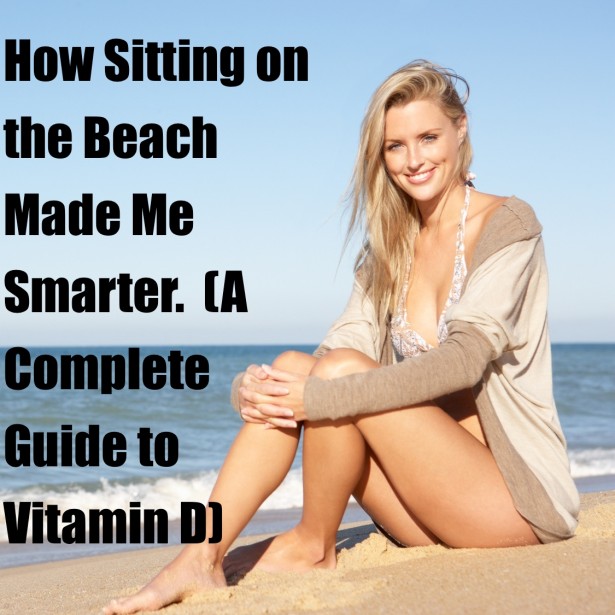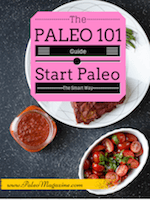How Sitting on the Beach Made Me Smarter. (A Complete Guide to Vitamin D)

You don’t want to be sick, fat, or dead. Nobody does.
So you try to do everything right. You try to eat better. You try to exercise. You take supplements. Everything.
And it’s hard. It’s hard to stay so good. I know because I’ve been trying for the past 15 years to be as healthy as possible. I always watch what I eat. I go to the gym 4 times per week. And I sleep. Boy, do I love to sleep.
But after years of trying so hard, I’ve learned that some things are more important than others.
No one thing will make you invincible, but there are some things you must do, and one of those really important things is getting enough Vitamin D.
I just got my own blood results back, and my Vitamin D level is right where I want it to be. In this article, I’ll explain exactly why you should make sure that you’re getting enough Vitamin D and how best to do it. And, at the end of this article, I’ll explain how sitting on the beach is making me a little bit smarter and healthier right now.
What the Heck is Vitamin D?
 It’s a silly question, right? Isn’t Vitamin D a vitamin?
It’s a silly question, right? Isn’t Vitamin D a vitamin?
Yes…and No. Let me get “science-y” on you for just a minute. You don’t need to remember all of this, but you need to appreciate that Vitamin D affects your cells at their most basic levels.
There are actually dozens of forms of Vitamin D. In the end, the Vitamin D that actually makes a difference in your body is a hormone. Most of the Vitamin D in your body is stored as “Calcidiol” (sometimes called 25(OH)D3). The active form, however, is called “Calcitriol.”
Vitamin D, as a hormone, acts like a signaling agent in your body. It does this in 2 ways: First, it can enter the nucleus of cells, attach to DNA, and turn certain gene expressions on or off. Secondly, it can also attach to the outside of a cell and change the functions of that cell.
In other words, Vitamin D literally changes how the cells in your body function. And it basically changes your genetics. It’s probably enough to know that Vitamin D has these functions, but here is why these functions are so important…
Why You REALLY Need Enough Vitamin D
Here are just a few examples of why Vitamin D is so important.
1. Bone Health. From Rickets to Ostomalacia to Osteoporosis, Vitamin D is crucial for bone health. Most importantly in this respect, your body can’t properly absorb or use calcium unless you have sufficient Vitamin D levels.
This means that you could be eating foods loaded with calcium, but it wouldn’t matter if your Vitamin D levels were too low to absorb and use that calcium. And without being able to absorb and use calcium, your bone density will be low, leading to weak and brittle bones.
2. Death. There’s no beating around the bush here. If you’re deficient in Vitamin D, you’re more likely to die from a variety of causes, including heart disease, as discussed below.
This doesn’t mean that you should get as much Vitamin D as possible, though, since too much can also lead to higher death rates. The key, like Goldilocks, is to get just enough.
3. Cancer. The relationship between Cancer and Vitamin D is worth mentioning, but it shouldn’t be over-emphasized. Overall, the evidence is not conclusive that sufficient Vitamin D levels help to prevent cancer.
However, there are a lot of pretty good studies showing that sufficient Vitamin D probably reduces the risk of cancer. It’s quite possible that being deficient in Vitamin D allows cancer cells to proliferate more quickly, which would prevent your body from dealing with them. As mentioned, though, this is not certain.
4. Vitamin D Keep You From Getting Sick. Not completely, of course. Nothing could do that. However, sufficient Vitamin D is important for the functioning of your innate immune system, which allows you to fight off both bacterial and viral infections.
You can certainly still get sick with sufficient Vitamin D levels, but your body will be much more able to fight off those infections.
5. Heart Disease. Several large studies have found that risk of heart disease is higher when you’re further away from the equator and during the winter months. Even after accounting for other factors, this appears to be largely attributable to lower Vitamin D levels.
And these aren’t the only potential problems that come from having too little Vitamin D. But they’re enough to make me want to get more.
“So How Much Vitamin D Do I Actually Need?”
Honestly, this is still a debated issue, although some people will try to tell you otherwise.
In all likelihood, it’s somewhere between 20-40ng/mL. Pretty much everybody agrees that if you’re under 20, you’re probably deficient. Many people suggest you need at least 30, but there is now some good evidence that going over 35 or 40 may actually be harmful.
If you want a really good and unbiased discussion of how much Vitamin D you need, then check out this post and podcast from Chris Kresser. In the end, if you’re close to 30, not many people or studies think that it’s too high or too low.
“Alright. I’m Convinced. How Can I Get More Vitamin D?”
There are 2 primary ways to get Vitamin D.
1. Get Some Sun. The first – and by far the best way to get Vitamin D – is through sun exposure. When your skin is exposed to UV-B rays from the sun, these UV-B rays start converting cholesterol (technically a substance that is almost cholesterol) in your skin into an inactive form of Vitamin D.
Once Vitamin D is produced in your skin, it’s converted by your liver into a different form of Vitamin D, and then finally by your kidneys into the active form of Vitamin D.
It’s a complicated process, but all you need to know is that for most people, spending just 30 minutes a day or so in the sun (without covering your skin) is generally enough to get plenty of Vitamin D.
2. Eat Some High-Vitamin D Foods. The second way to get Vitamin D is by eating it. Some foods (like salmon, sardines, beef liver, duck eggs, and a variety of other seafood) are relatively high in Vitamin D, which also has to be converted by your liver and then your kidneys into active forms.
Some cultures (such as the Inuit) have gotten almost all of their Vitamin D from foods, but it’s rare and difficult to be able to do this. The much easier route is getting enough sun exposure.
As an aside, you can also take Vitamin D supplements. If you’re seriously low or can’t get foods high in Vitamin D, then this is something you might want to talk to your doctor about.
“Just Spell It Out For Me. How Much Sunlight Should I Get?”
I want to give you an easy answer. I really do. But you have to consider a few big factors:
1. Where Do You Live? If you live near the equator, then you’re probably getting a lot more UVB light every day. If you live in Canada, you’re getting much less, and you probably need to stay outside for longer.
2. What Time of Year Is It? UVB light is actually affected by the angle at which the light hits the earth. So, for several months during the Winter (whenever it happens in your part of the world), you might get almost no UVB light. It’s estimated that New York City, for example, has 3-5 months during winter when it receives very little UVB light.
3. How Dark is Your Skin? If you’re pale and white, then you need much less time out in the sun. The darker your skin color, the more time you need in the sun every day to produce adequate amounts of Vitamin D.
In general, most people need somewhere between 20 minutes and an hour per day, so it’s not really all that much time. Remember, though, if you’re wearing a lot of clothes, that also decreases your exposure.
Also, it’s probably best to slowly and gradually increase your time in the sun if you’re not accustomed to it, as getting sunburnt is still quite bad for you.
Obviously, there are times of year and places around the world where getting enough Vitamin D is either tough or impossible. If you’re in one of those situations, then it probably makes sense to focus more on eating foods that are high in Vitamin D (discussed below).
What You Need to Know About Sunscreen
As mentioned above, your body creates Vitamin D from Cholesterol when your skin is exposed to UVB light.
Sunscreen effectively blocks all UVB light from reaching your skin, which means that your body is not able to produce pretty much any Vitamin D when you’re wearing sunscreen.
In addition, if you’re just getting light through a window, pretty much all UVB light is blocked.
Finally, tanning beds rely primarily on UVA light, meaning that they also fail to cause the production of Vitamin D in your body.
“I Don’t Like the Sun. Can’t I Just Get My Vitamin D from Food?”
Yup. You can get Vitamin D from food, but it’s much harder to get enough of, and it’s also much easier to get too much (ironically).
For the most part, the best sources of Vitamin D are seafood and the blood of land animals. (Click here to see a full chart). And blood isn’t too popular these days. Eggs are also a good source.
Plants are generally not a great source of Vitamin D. Most Vitamin D found in Animals is in the form of D3, which is about 5-10 times more potent (better) than D2, which is the primary type of Vitamin D found in plants.
Just remember, when you’re getting Vitamin D from sunlight, your body has mechanisms that make it hard to get too much (your skin starts getting tan, which lowers the conversion of cholesterol to Vitamin D). When you get Vitamin D from food (or from supplements), your body doesn’t have this protection mechanism.
Like I noted above, in some parts of the world, and at certain times of year, getting Vitamin D from food might be a necessity. But it’s not optimal.
One Last Warning: You Can Definitely Get Too Much Vitamin D
It’s absolutely true. Vitamin D can definitely be toxic at certain levels. However, it’s a bit complicated.
Vitamin D actually works together with Vitamins A and K2, meaning that if you’re deficient in A and/or K2, then Vitamin D becomes toxic at lower levels.
In the end, it’s impossible right now to say how much Vitamin D would be too much, but there have been several good studies showing adverse effects if you have blood levels of Vitamin D above 40 or 50 ng/mL.
Most people are deficient in Vitamin D, but if you think you’re getting too much, or if you’re thinking about supplementing, be sure to make sure that you’re also getting enough Vitamin A and K2.
Hanging Out at the Beach
I’m actually writing this article on the beach. I don’t live here, but I’m traveling right now.
I’ve been in the sun a bit more lately, and although it’s almost certainly not an effect of getting more Vitamin D, I already feel better.
Getting enough Vitamin D is hugely important for your health, but getting out into nature and into the sun is just good for you overall. You know this already, because whenever you go to the beach or out hiking, you probably immediately feel better, right?
I’m writing this article on the beach because it’s made me think again about how important it is. Some things you “know,” but you don’t really know them until they fall on top of you (much like the sun is falling on me right now). And really, what’s better than getting healthier on the beach while also hopefully helping a few more people get healthier?
Not much.
Images: Copyright (c) Monkey Business from Fotolia and soft_light from Fotolia

